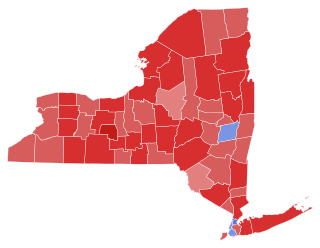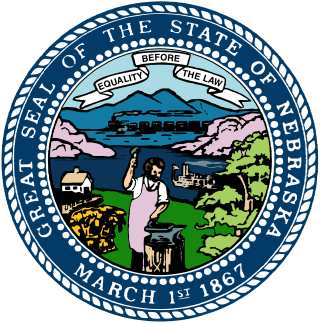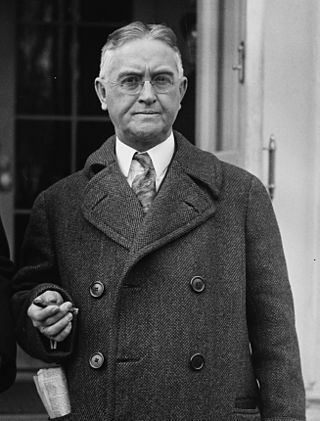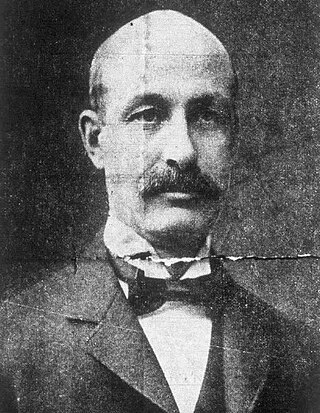
The 1946 New York state election was held on November 5, 1946, to elect the governor, the lieutenant governor, the state comptroller, the attorney general, a U.S. Senator, the chief judge and an associate judge of the New York Court of Appeals, as well as all members of the New York State Assembly and the New York State Senate.

The 1974 Nebraska gubernatorial election was held on November 5, 1974, and featured incumbent Governor James Exon, a Democrat, defeating Republican nominee, state Senator Richard D. Marvel. Independent state Senator Ernie Chambers also captured 5% of the vote as a write-in candidate. This was the first gubernatorial election in Nebraska in which the nominees for Governor and Lieutenant Governor ran as a single ticket in the general election, though they were chosen in separate primary elections.

The 1924 Nebraska gubernatorial election was held on November 4, 1924, and featured former state Senator Adam McMullen, a Republican, defeating Democratic nominee, former state Representative John N. Norton, and Progressive nominee, Omaha City Commissioner Dan B. Butler.

The 1880 Maine gubernatorial election was held on September 13, 1880 for a two-year term that was scheduled to run from January 13, 1881 to January 3, 1883. The contest resulted in the victory of Greenback and Democratic nominee Harris M. Plaisted, who narrowly defeated incumbent Republican governor Daniel F. Davis, one of the few times Republicans lost control of the governorship between the founding of the party in the 1850s and the Great Depression. This was the first gubernatorial election in Maine in which a plurality of the popular vote was sufficient to elect the governor, in accordance with a constitutional amendment ratified the same day.

The 1910 Nebraska gubernatorial election was held on November 8, 1910.

The 1900 Nebraska gubernatorial election was held on November 6, 1900.

The 1898 Nebraska gubernatorial election was held on November 8, 1898. Incumbent Populist Governor Silas A. Holcomb did not stand for re-election. Populist and Democratic fusion nominee William A. Poynter defeated Republican nominee Monroe Hayward with 50.19% of the vote.

The 1882 Nebraska gubernatorial election was held on November 7, 1882. Incumbent Republican governor Albinus Nance did not seek reelection. This election featured James W. Dawes, a Republican, defeating Democratic nominee J. Sterling Morton and Greenback nominee Edward P. Ingersoll.

The 1878 Nebraska gubernatorial election was held on November 5, 1878. Incumbent Republican governor Silas Garber did not seek reelection. This election featured Republican nominee Albinus Nance, the Speaker of the Nebraska House of Representatives, defeating Democratic nominee Colonel William H. Webster, a lawyer from Merrick County, Nebraska, and Greenback Party nominee Levi G. Todd, a former member of the Nebraska Territorial House of Representatives from Cass County, Nebraska.

The 1876 Nebraska gubernatorial election was held on November 7, 1876. It was the first election held under the newly adopted Nebraska Constitution of 1875. The election featured incumbent Governor Silas Garber, a Republican, defeating Democratic nominee Paren England, a lawyer from Lancaster County, Nebraska, and Greenback Party nominee Jonathan F. Gardner, former independent candidate for Governor of Nebraska in 1874.

The 1876 Nebraska lieutenant gubernatorial election was held on November 7, 1876, and featured Republican nominee Othman A. Abbott defeating Democratic nominee Miles Zentmeyer and Greenback Party nominee Allen Root.

The 1880 Nebraska lieutenant gubernatorial election was held on November 2, 1880, and featured incumbent Nebraska Lieutenant Governor Edmund C. Carns, a Republican, defeating Democratic nominee T. J. Hamilton as well as Greenback nominee Peter Lansing and former Democratic nominee Samuel H. Calhoun. Originally, the Democratic party had nominated Calhoun for lieutenant governor. However, on October 11, 1880, Calhoun withdrew his candidacy, and the Democratic state central committee appointed T. J. Hamilton to replace him.

The 1882 Nebraska lieutenant gubernatorial election was held on November 7, 1882, and featured Republican nominee Alfred W. Agee defeating Democratic nominee Jesse F. Warner as well as Greenback nominee D. P. Reynolds.

The 1884 Nebraska lieutenant gubernatorial election was held on November 4, 1884, and featured Republican nominee Hibbard H. Shedd defeating fusion Democratic and Greenback (Anti-Monopoly) nominee Lewis C. Pace. Incumbent Nebraska Lieutenant Governor Alfred W. Agee was renominated at the Nebraska Republican state convention, but he was defeated for the nomination by Shedd by a vote of 292 to 153 of the delegates.

The 1890 Nebraska lieutenant gubernatorial election was held on November 4, 1890, and featured Republican nominee Thomas Jefferson Majors defeating Populist nominee William H. Dech and Democratic nominee Alex Bear as well as Prohibition Party nominee George W. Woodbey. Incumbent Nebraska Lieutenant Governor George D. Meiklejohn did not seek reelection as lieutenant governor in order to seek the Republican nomination for the US House of Representatives in Nebraska's 3rd congressional district, but he was unsuccessful.

The 1894 Nebraska lieutenant gubernatorial election was held on November 6, 1894, and featured Republican nominee Robert E. Moore defeating Populist and Democratic fusion nominee James N. Gaffin as well as Straight Democratic (anti-Populist) nominee Rodney E. Dunphy and Prohibition Party nominee Belle G. Bigelow.

The 1896 Nebraska lieutenant gubernatorial election was held on November 3, 1896, and featured Populist and Democratic fusion nominee James E. Harris defeating his major rival, Republican nominee Orlando Tefft. Other candidates who received two percent of the vote or less included Gold Democratic nominee Owen F. Biglin, Prohibition nominee Lucius O. Jones, Socialist Labor nominee Fred Herman, and National Silver nominee Oscar Kent. Incumbent Nebraska Lieutenant Governor Robert E. Moore did not seek reelection.

The 1898 Nebraska lieutenant gubernatorial election was held on November 8, 1898, and featured Populist and Democratic fusion nominee Edward A. Gilbert defeating Republican nominee George A. Murphy as well as Prohibition nominee Newell S. Lowrie and Socialist Labor nominee J. J. Kerrigan.

The 1902 Nebraska lieutenant gubernatorial election was held on November 4, 1902, and featured Republican nominee Edmund G. McGilton defeating Edward A. Gilbert, the Populist and Democratic fusion nominee, as well as Prohibition nominee Isaiah Lightner and Socialist nominee Andrew D. Peugh.

The 1904 Nebraska lieutenant gubernatorial election was held on November 8, 1904, and featured incumbent Nebraska Lieutenant Governor Edmund G. McGilton, a Republican, defeating Adelbert Townsend, the Populist and Democratic fusion nominee, as well as Prohibition nominee Isaiah Lightner and Socialist nominee Thomas Carroll.











